Peugeot 508 RXH 2013 Service Manual
Manufacturer: PEUGEOT, Model Year: 2013, Model line: 508 RXH, Model: Peugeot 508 RXH 2013Pages: 308, PDF Size: 8.95 MB
Page 41 of 308
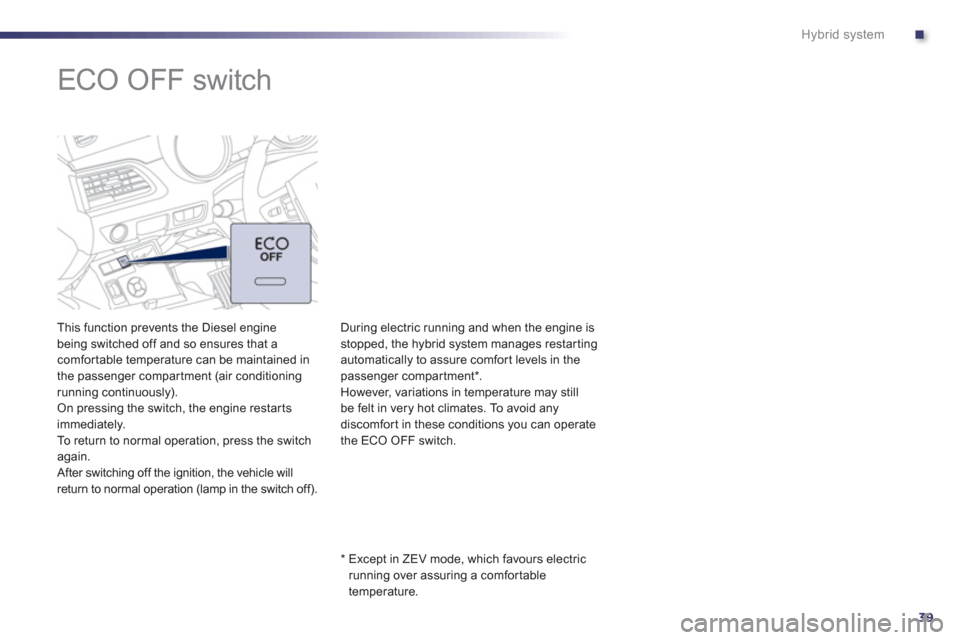
.
39
Hybrid system
ECO OFF switch
This function prevents the Diesel engine
being switched off and so ensures that a comfor table temperature can be maintained in
the passenger compar tment (air conditioningrunning continuously).
On pressing the switch, the engine restar ts
immediately.
To return to normal operation, press the switch
a
gain.
After switching off the ignition, the vehicle will
return to normal operation (lamp in the switch off).
*
Except in ZEV mode, which favours electricrunning over assuring a comfortable
temperature. Durin
g electric running and when the engine is
stopped, the hybrid system manages restarting automatically to assure comfor t levels in thepassenger compartment * .However, variations in temperature may stillbe felt in very hot climates. To avoid any
discomfort in these conditions you can operate
the E
CO OFF switch.
Page 42 of 308
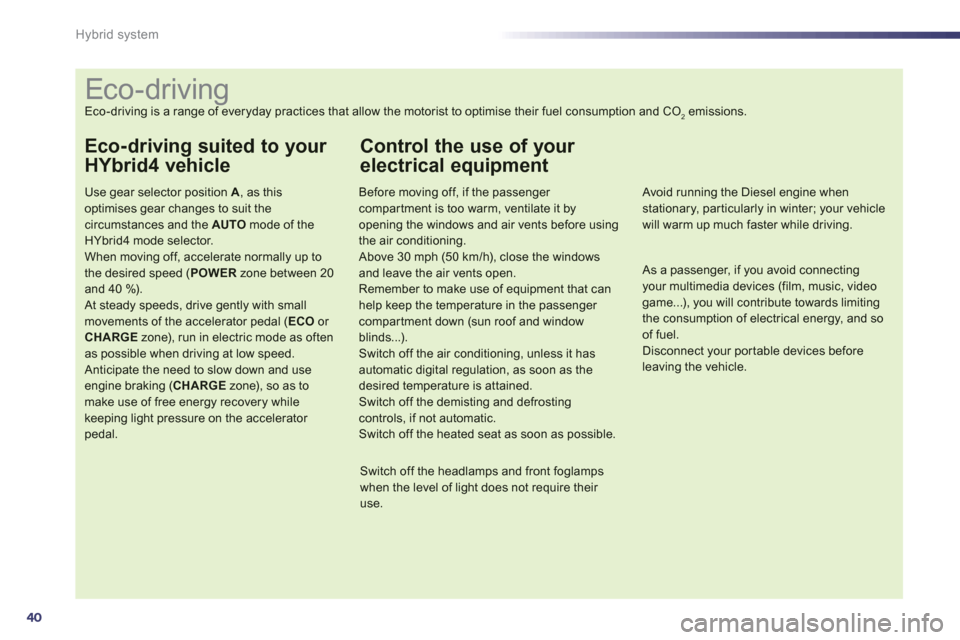
40
Hybrid system
Eco-driving
Eco-driving is a range of everyday practices that allow the motorist to optimise their fuel consumption and CO2emissions.
Eco-driving suited to your
HYbrid4 vehicle
Use gear selector position A , as thisoptimises gear changes to suit the
circumstances and the AUTOmode of theHYbrid4 mode selector. When moving off, accelerate normally up tothe desired speed (POWER
zone between 20and 40 %).
At steady speeds, drive gently with smallmovements of the accelerator pedal (ECO
or CHARGEzone), run in electric mode as oftenas possible when driving at low speed. Anticipate the need to slow down and use engine braking ( CHARGE
zone), so as to make use of free energy recovery while keeping light pressure on the accelerator pedal.
Control the use of your
electrical equipment
Before moving off, if the passenger compartment is too warm, ventilate it byopening the windows and air vents before using the air conditioning.
Above 30 mph (50 km/h), close the windows and leave the air vents open.
Remember to make use of equipment that canhelp keep the temperature in the passenger compartment down (sun roof and windowblinds...). Switch off the air conditioning, unless it has automatic digital regulation, as soon as thedesired temperature is attained. Switch off the demisting and defrostingcontrols, if not automatic.
Switch off the heated seat as soon as possible.
Switch off the headlamps and front foglampswhen the level of light does not require their use.
Avoid running the Diesel engine when stationary, par ticularly in winter; your vehicle will warm up much faster while driving.
As a passenger, if you avoid connecting your multimedia devices (film, music, videogame...), you will contribute towards limitingthe consumption of electrical energy, and soof fuel.
Disconnect your por table devices beforeleaving the vehicle.
Page 43 of 308
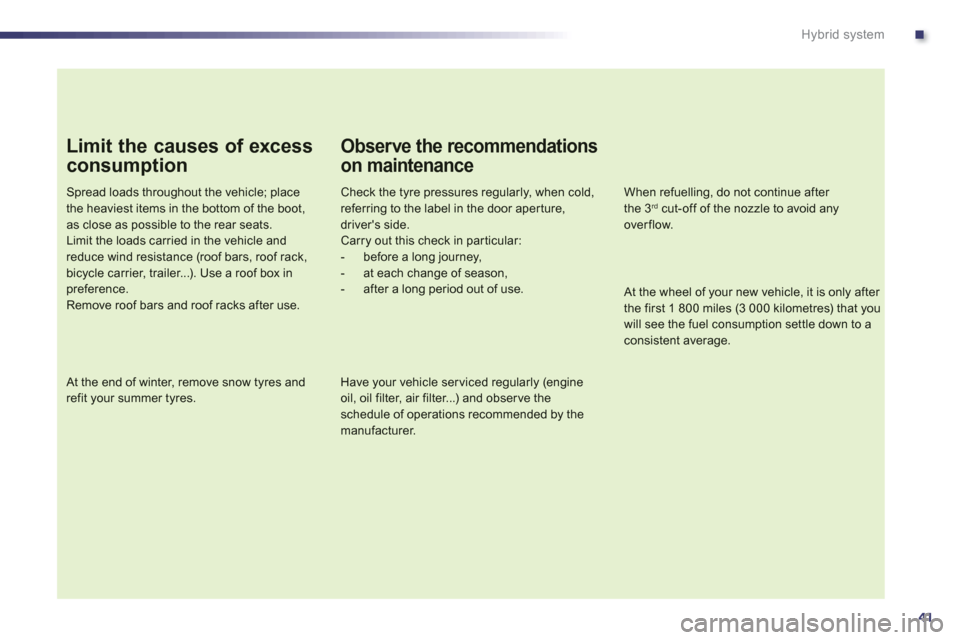
.
41
Hybrid system
Limit the causes of excess
consumption
Spread loads throughout the vehicle; placethe heaviest items in the bottom of the boot,
as close as possible to the rear seats.Limit the loads carried in the vehicle and reduce wind resistance (roof bars, roof rack, bicycle carrier, trailer...). Use a roof box inpreference.Remove roof bars and roof racks after use.
At the end of winter, remove snow tyres and refit your summer tyres.
Observe the recommendations
on maintenance
Check the tyre pressures regularly, when cold, referring to the label in the door aper ture, driver's side.Carry out this check in par ticular:- before a long journey,- at each change of season,- after a long period out of use.
When refuelling, do not continue after the 3rdcut-off of the nozzle to avoid any overflow.
Have your vehicle ser viced regularly (engine oil, oil filter, air filter...) and obser ve the schedule of operations recommended by the
manufacturer.
At the wheel of your new vehicle, it is only after the first 1 800 miles (3 000 kilometres) that youwill see the fuel consumption settle down to aconsistent average.
Page 44 of 308
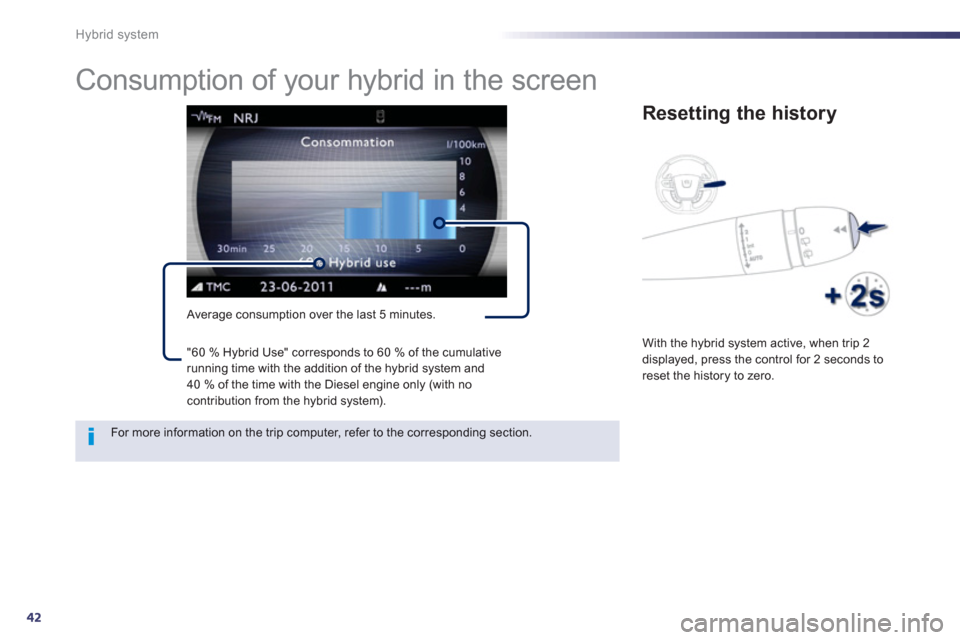
42
Hybrid system
Consumption of your hybrid in the screen
Average consumption over the last 5 minutes.
Resetting the history
With the hybrid system active, when trip 2displayed, press the control for 2 seconds to
reset the history to zero.
For more information on the trip computer, refer to the corresponding section. "60 % H
ybrid Use" corresponds to 60 % of the cumulative running time with the addition of the hybrid system and
40 % of the time with the Diesel engine only (with nocontribution from the hybrid system).
Page 45 of 308
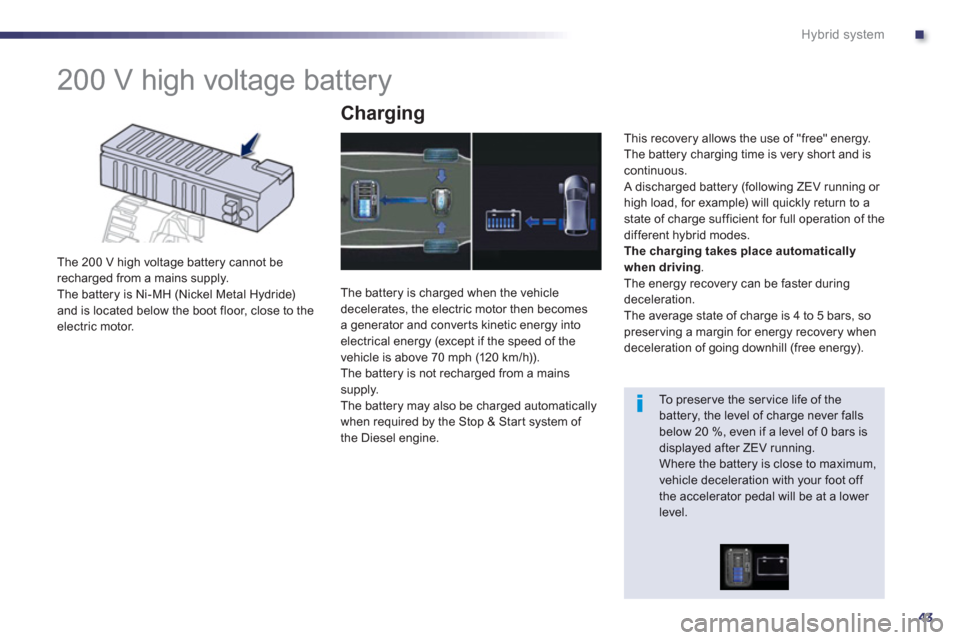
.
43
Hybrid system
200 V high voltage battery
The 200 V high voltage battery cannot be
recharged from a mains supply.
The battery is Ni-MH (Nickel Metal Hydride)
and is located below the boot floor, close to the electric motor.
Charging
The battery is charged when the vehicledecelerates, the electric motor then becomesa generator and conver ts kinetic energy into
electrical energy (except if the speed of the
vehicle is above 70 mph (120 km / h)).
The battery is not recharged from a mains
supply.
The battery may also be charged automaticallywhen required by the Stop & Start system of
the Diesel engine.
This recover
y allows the use of "free" energy.
The battery charging time is very shor t and iscontinuous.
A discharged battery (following ZEV running or
high load, for example) will quickly return to astate of charge sufficient for full operation of the
different hybrid modes.
Thecharging takes place automatically
when driving.
The energy recovery can be faster during deceleration.
The average state of charge is 4 to 5 bars, so
preserving a margin for energy recovery when
deceleration of going downhill (free energy).
To preser ve the ser vice life of the battery, the level of charge never fallsbelow 20 %, even if a level of 0 bars isdisplayed after ZEV running. Where the battery is close to maximum,vehicle deceleration with your foot off the accelerator pedal will be at a lower level.
Page 46 of 308
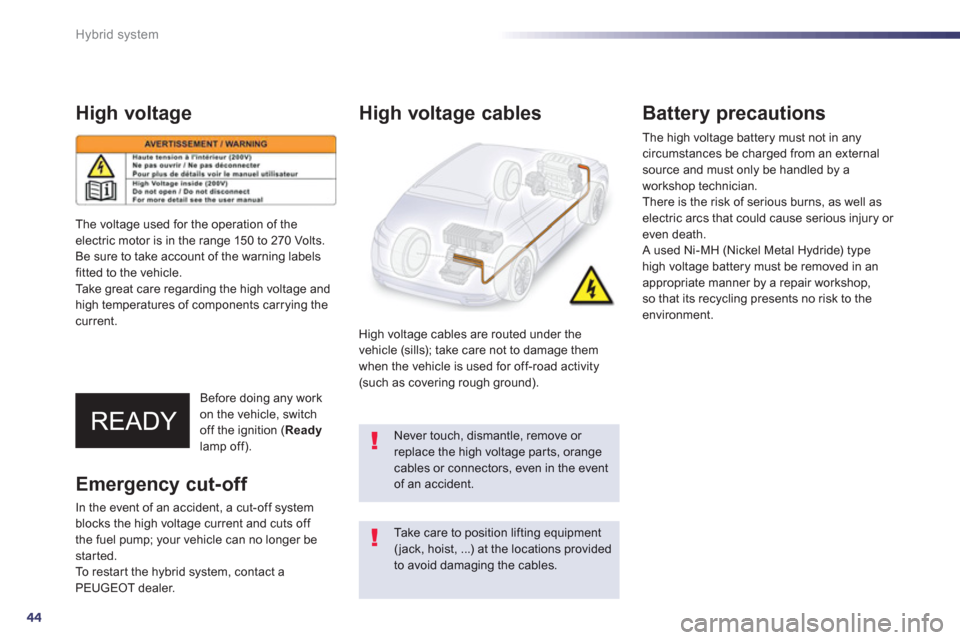
44
Hybrid system
High voltage
Before doing any work
on the vehicle, switch
off the ignition ( Readylamp off).
High voltage cables
High voltage cables are routed under the
vehicle (sills); take care not to damage them
when the vehicle is used for off-road activity(such as covering rough ground).
Battery precautions
The high voltage battery must not in anycircumstances be charged from an external source and must only be handled by a
workshop technician.
There is the risk of serious burns
, as well as electric arcs that could cause serious injury or even death.
A used Ni-MH (Nickel Metal Hydride) type high voltage battery must be removed in an
appropriate manner by a repair workshop,
so that its recycling presents no risk to the environment.
Take care to position lifting equipment(jack, hoist, ...) at the locations provided to avoid damaging the cables.
The volta
ge used for the operation of theelectric motor is in the range 150 to 270 Volts.
Be sure to take account of the warning labels
fitted to the vehicle. Take great care regarding the high voltage andhigh temperatures of components carrying the current.
Emergency cut-off
In the event of an accident, a cut-off system
blocks the high voltage current and cuts off
the fuel pump; your vehicle can no longer bestarted.
To restar t the hybrid system, contact a
PE
UGEOT dealer.
Never touch, dismantle, remove or replace the high voltage par ts, orangecables or connectors, even in the event of an accident.
Page 47 of 308
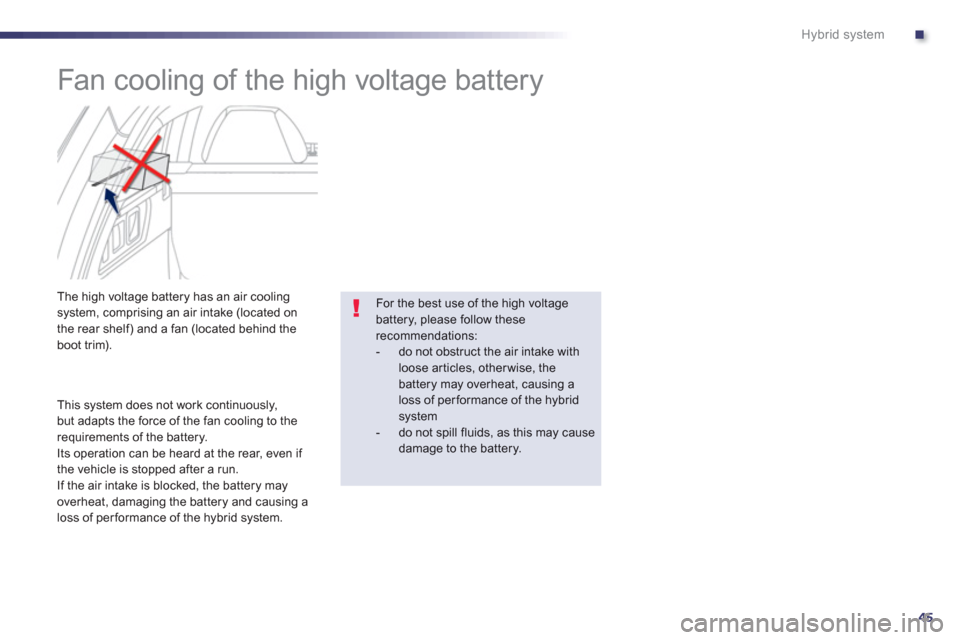
.
45
Hybrid system
Fan cooling of the high voltage battery
The high voltage battery has an air coolingsystem, comprising an air intake (located on
the rear shelf) and a fan (located behind the
boot trim).
This s
ystem does not work continuously,
but adapts the force of the fan cooling to the
requirements of the battery.
Its operation can be heard at the rear, even if
the vehicle is stopped after a run.
If the air intake is blocked, the battery mayoverheat, damaging the battery and causing a
loss of performance of the hybrid system.
For the best use of the high voltage battery, please follow these recommendations: - do not obstruct the air intake with loose articles, otherwise, thebattery may overheat, causing a loss of performance of the hybrid system - do not spill fluids, as this may cause damage to the battery.
Page 48 of 308
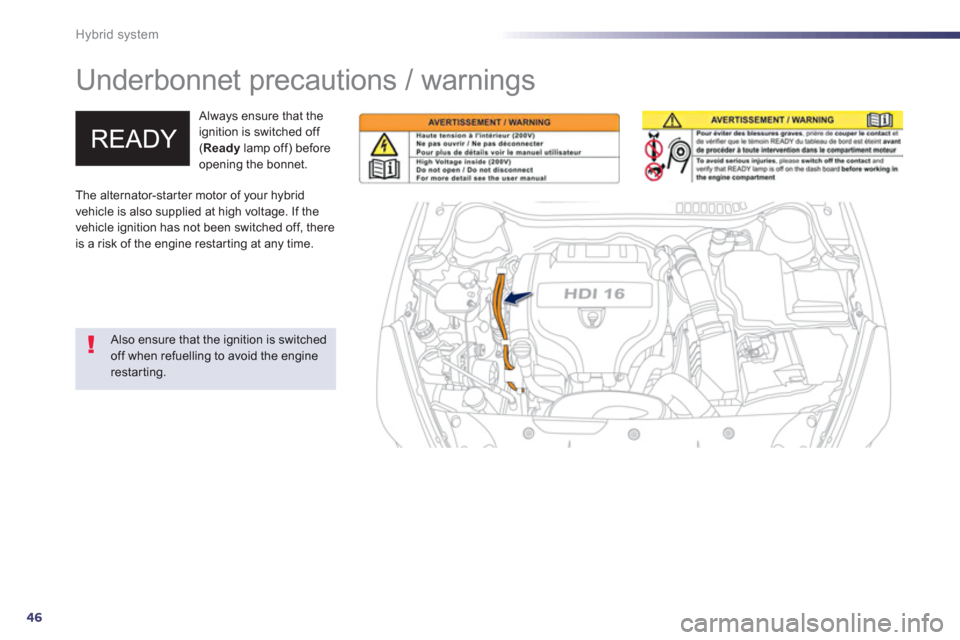
46
Hybrid system
Underbonnet precautions / warnings
Always ensure that the
ignition is switched off (Readylamp off) before
opening the bonnet.
Also ensure that the ignition is switched off when refuelling to avoid the engine restarting. The alternator-star ter motor o
f your hybrid
vehicle is also supplied at high voltage. If the
vehicle ignition has not been switched off, there
is a risk of the engine restar ting at any time.
Page 49 of 308
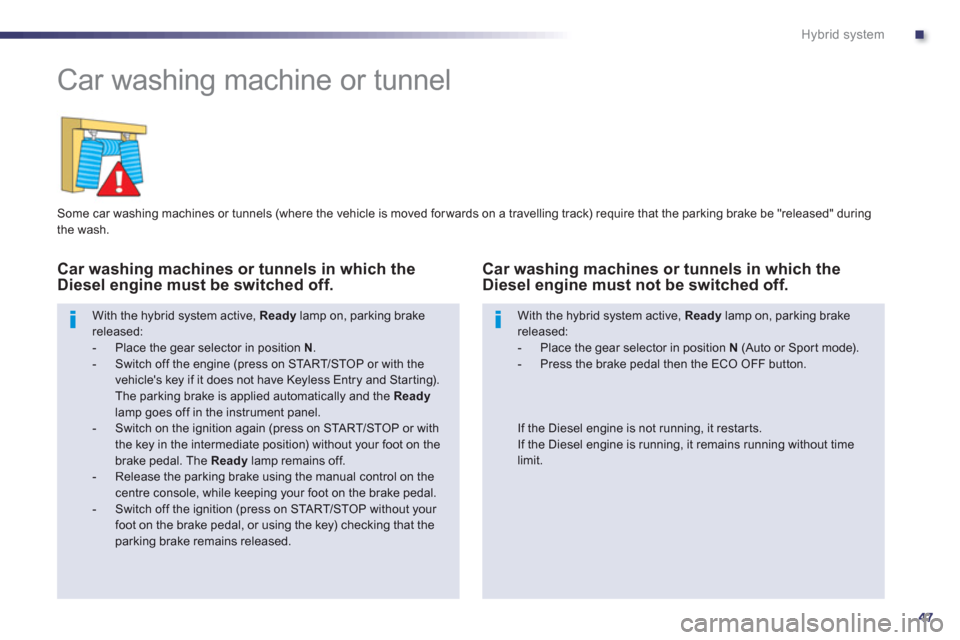
.
47
Hybrid system
Car washing machine or tunnel
Some car washing machines or tunnels (where the vehicle is moved for wards on a travelling track) require that the parking brake be "released" during
th
e wash.
Car washing machines or tunnels in which theDiesel engine must be switched off.
With the hybrid system active, Readylamp on, parking brakereleased:- Place the gear selector in position N.- Switch off the engine (press on STA R T/STOP or with thevehicle's key if it does not have Keyless Entry and Starting).The parking brake is applied automatically and the Readylamp goes off in the instrument panel.- Switch on the ignition again (press on START/STOP or with
the key in the intermediate position) without your foot on the brake pedal. The Readylamp remains off. - Release the parking brake using the manual control on the centre console, while keeping your foot on the brake pedal.- Switch off the ignition (press on STA R T/STOP without your foot on the brake pedal, or using the key) checking that the parking brake remains released.
With the hybrid system active, Ready
lamp on, parking brake released:
- Place the gear selector in position N
(Auto or Sport mode).
- Press the brake pedal then the ECO OFF button.
Car washing machines or tunnels in which the Diesel engine must not be switched off.
If the Diesel engine is not running, it restar ts.
If the Diesel engine is running, it remains running without time limit.
Page 50 of 308

48
Hybrid system
Vehicle recovery
position N
, then switch off the hybrid system.
If necessary because access to the vehicle is difficult, it can be moved a few dozen metres at a speed not exceeding 6 mph (10 km/h).
Th
e front or rear wheels must not be on theground, use a flat-bed lorry or trailer to recover
the vehicle.
Use the towin
g eyes only to pull a vehicle out or
to pull it onto a flat-bed.